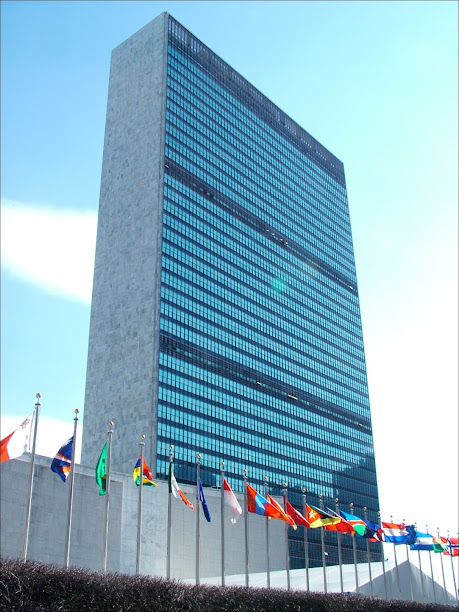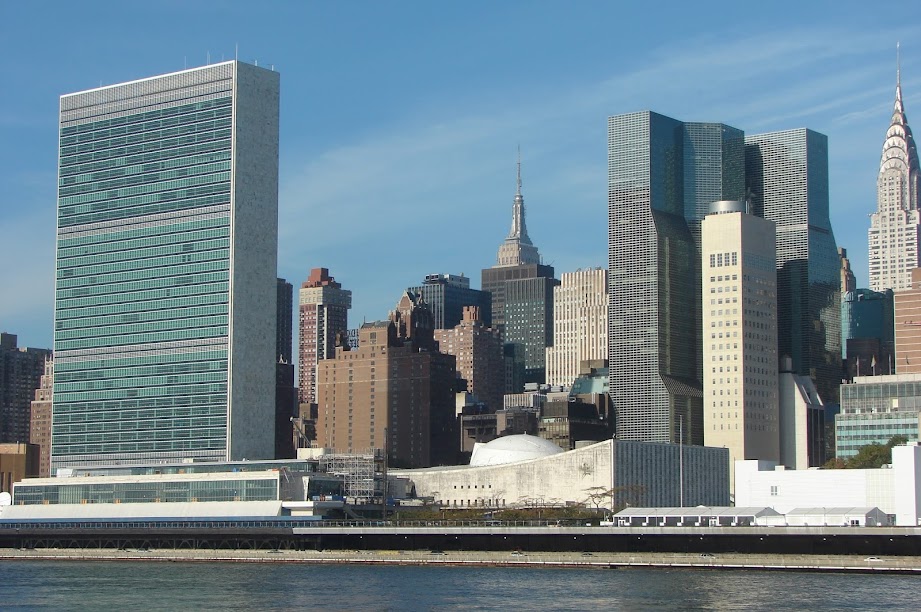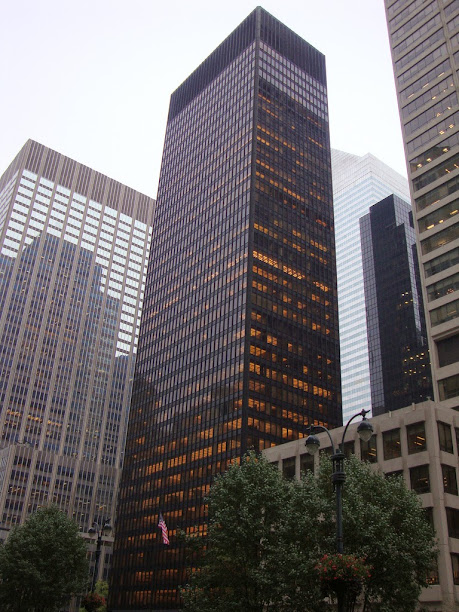From the early 1930s to the late 1980s, International Style architecture was the main choice for office buildings and other large commercial or institutional projects, especially in the US and Canada. The resulting skyscrapers reshaped major cities and gave them the skylines they are famous for today.
 Le Corbusier, Oscar Niemeyer and Wallace Harrison, United Nations Headquarters, built 1948-1952, New York — Photo by Selwyn Manning
Le Corbusier, Oscar Niemeyer and Wallace Harrison, United Nations Headquarters, built 1948-1952, New York — Photo by Selwyn Manning
The United Nations Headquarters in New York is a great example of International Style architecture, perfectly illustrating the main characteristics of the movement:
– Glass façades
– Steel frames
– Simple square or rectangular forms / straight lines and 90° angles
– No decorations
– Large open spaces
 United Nations Headquarters in New York skyline — Photo by Hajat Avdovic
United Nations Headquarters in New York skyline — Photo by Hajat Avdovic
These characteristics, as well as the name “International Style,” come from the exhibition “Modern Architecture – International Exhibition” held in New York in 1932, which was the first architecture exhibition at the Museum of Modern Art.
Even though the style is strongly associated with Chicago and New York, it is not purely American. It is the fusion of modern ideas and building techniques developed at the German Bauhaus school of design and in the US in the 1920s. Other European architects, such as Le Corbusier, also contributed to its development before it was defined as a style and given a name at the New York exhibition.
Let’s take a look at other works in the International Style by key architects of the movement, starting with one of the most prolific, Ludwig Mies van der Rohe:
 Ludwig Mies van der Rohe and Philip Johnson, Seagram Building, built in 1958, New York — Photo by Tom Ravenscroft
Ludwig Mies van der Rohe and Philip Johnson, Seagram Building, built in 1958, New York — Photo by Tom Ravenscroft
 Ludwig Mies van der Rohe, Parkin and Associates, Bregman and Hamann Architects, Toronto-Dominion Centre, built 1967-1969, Toronto — © Cadillac Fairview Corporation Limited
Ludwig Mies van der Rohe, Parkin and Associates, Bregman and Hamann Architects, Toronto-Dominion Centre, built 1967-1969, Toronto — © Cadillac Fairview Corporation Limited
 Ludwig Mies van der Rohe, IBM Plaza / AMA Plaza, built 1966-1973, Chicago
Ludwig Mies van der Rohe, IBM Plaza / AMA Plaza, built 1966-1973, Chicago
Another major name is Walter Gropius, who founded the Bauhaus school of design in 1919:
 Walter Gropius, John F. Kennedy Federal Building, built 1963-1966, Boston — © LeMessurier
Walter Gropius, John F. Kennedy Federal Building, built 1963-1966, Boston — © LeMessurier
Other famous examples include:
 I.M. Pei and Partners, Place Ville Marie, built 1958-1962, Montreal — Photo by Stephan Poulin
I.M. Pei and Partners, Place Ville Marie, built 1958-1962, Montreal — Photo by Stephan Poulin
 Skidmore, Owings and Merrill, Sears Tower / Willis Tower, built 1970-1973, Chicago — Photo by Daniel Schwen
Skidmore, Owings and Merrill, Sears Tower / Willis Tower, built 1970-1973, Chicago — Photo by Daniel Schwen
Early International Style buildings are on a smaller scale and also include private houses, but the movement’s main contribution is definitely the rectangular skyscraper made of glass and steel with no decoration, which can be found in almost every major city around the world today.
Pingback: The Metal Frame Revolution « the westologist